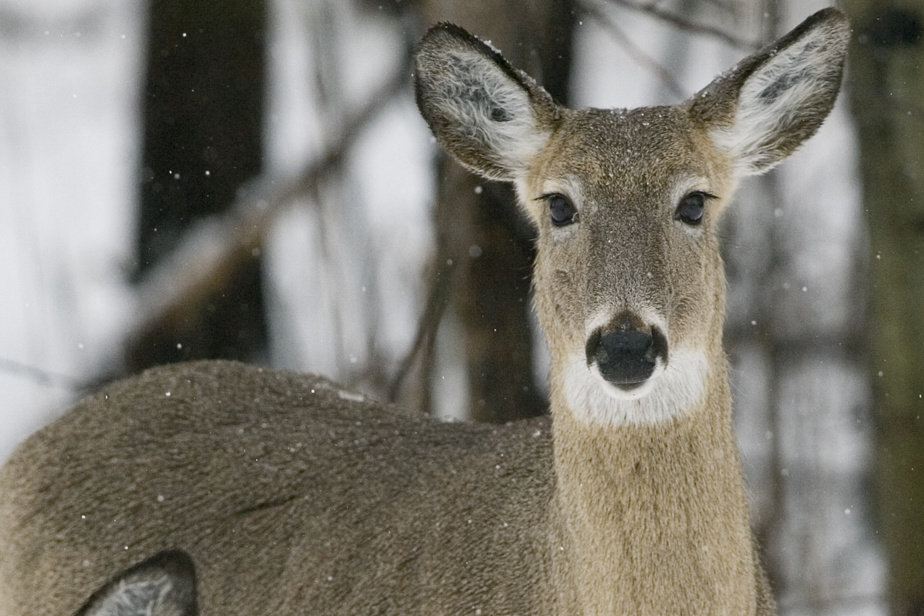Many animals remain active in winter. But their life is not easy and they certainly don’t want humans to bother them by getting a little too close. The problem is that outdoor enthusiasts often have good intentions and are unaware that they are bothering winter wildlife.
“Animals face a triple challenge in winter,” explains Marc-André Villard, biologist at SEPAQ. First there is the cold, which causes heat loss. To compensate for this, animals must eat, but food is more scarce for many species. »
For herbivores, of course, but also for insectivores.

PHOTO DAVID BOILY, LA PRESSE ARCHIVES
The black-capped chickadee has a hard time finding food during the winter.
“For them, there is practically no food. For example, the only insects that titmice will be able to find are found in crevices, in the bark. »
The other big challenge is reduced mobility.
We think of a deer, for example, which is not really adapted to deep snow. Even a moose will smash through the snow. They really need to choose wintering sites where there is plenty of food and where there is not too much risk of predation.
Marc-André Villard, biologist at SEPAQ
The danger is that the presence of humans can force the animal to move.
“It’s a big loss of energy and they can end up in habitats that are less suitable, either because there are more predators or because there is less food,” says Marc-André Villard.

PHOTO DAVID BOILY, LA PRESSE ARCHIVES
Caribou must be careful of predators.
To get away, large deer will tend to take well-trodden paths and trails rather than going into deep snow.
“The bad reflex to have is to follow the animal,” says Marc-André Valiquette, ecologist at La Mauricie National Park. It may seem magical, the proximity of an animal, but he is under stress, he expends a lot of energy, he is moving away from the place where he had planned to spend the winter or the next days. There are behaviors like this that may seem harmless, but can have serious consequences on wildlife. »
Adopt good behaviors
The right thing to do when seeing an animal is to stop, observe its behavior and give it space. For large wildlife, we are talking about a distance of around fifty meters. This can be an opportunity to take out the binoculars and take a break to eat a snack and give the animal a good head start.
“I go hiking myself,” notes Mr. Valiquette. I know it’s not easy to turn back, even if it could be wiser, especially if the snow conditions are very difficult for the animal. »
Marc-André Villard reviewed the scientific literature on the subject. We see that predictable activities disturb wildlife less. By “predictable”, we are talking about traffic along well-established trails, whether snowshoeing, cross-country skiing or snowmobiling.
“It’s when it’s unexpected, like off-piste skiers, that it’s more damaging. But should we stop off-piste skiing? You shouldn’t go crazy either. »
The site manager can then play a prevention role by identifying and prohibiting areas where there are moose or caribou settling in for the winter.
To protect wildlife in winter, outdoor enthusiasts should also avoid feeding animals, either directly or by leaving trash lying around.
Feeding herbivores like ungulates is out of the question, it causes dependence. Additionally, the food people give them is not nutritious.
Marc-André Villard, biologist at SEPAQ
Animals and birds risk losing their natural fear of humans and establishing a direct link between them and food.
“The animal’s food-seeking behavior becomes more and more aggressive towards humans,” maintains Marc-André Valiquette. He will go and beg for food, pierce the backpacks. »
Birds can eat out of people’s hands.
“It makes for great photos, but again, it’s aberrant behavior,” says Mr. Valiquette.
Soon, these same birds will make stealth flights to snatch a piece of sandwich from the hiker’s hands.
“Feeding is a behavior to be avoided so that animals know how to fend for themselves, so that they continue to eat without external input,” he declares.
Video suggestion
A video to listen to
The ptarmigan is very pretty. But it’s his vocalizations that are out of the ordinary.
Number of the week
25%
White-tailed deer can lose up to 25% of their weight during the winter season without threatening their survival.
Source: Ministry of the Environment, the Fight against Climate Change, Wildlife and Parks
